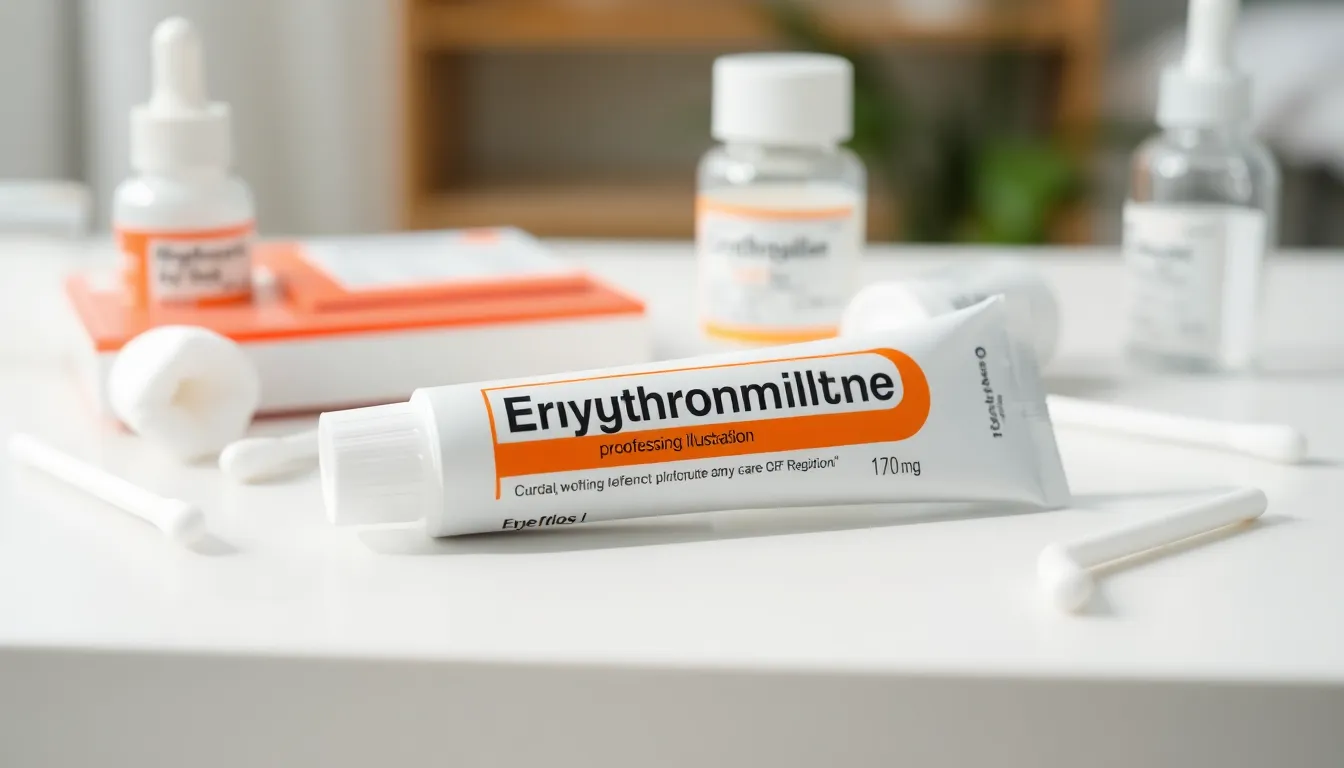Table of Contents
ToggleWhen it comes to eye care, few things are as crucial as knowing how to apply medication correctly. Erythromycin eye ointment is a trusty sidekick in the battle against eye infections, but applying it can feel like trying to juggle while riding a unicycle. Fear not! With a little guidance, anyone can master the art of ointment application and keep their peepers happy and healthy.
Overview of Erythromycin Eye Ointment
Erythromycin eye ointment serves as an antibiotic treatment, targeting bacterial infections in the eyes. This medication is particularly effective against conjunctivitis and other similar conditions. Patients commonly use it to reduce inflammation and alleviate symptoms associated with eye infections.
The ointment’s formulation allows for direct application to the affected area, ensuring effective treatment. Users typically find it easy to use at home, following a few straightforward steps. In addition, it is important to keep the ointment free from contaminants to maintain its effectiveness.
Dosage often depends on the severity of the infection. Healthcare professionals frequently recommend applying the ointment one to three times daily. Adhering to the prescribed schedule maximizes its efficacy and promotes faster healing.
While using erythromycin eye ointment, patients may experience some mild side effects. Temporary blurred vision and slight irritation after application are common occurrences. If severe reactions manifest, users should consult a healthcare provider for guidance.
Overall, understanding proper application techniques contributes to the success of the treatment. Clear instructions ensure that users can effectively apply the ointment, leading to better eye health outcomes. Proper storage conditions also matter, as keeping the ointment in a cool, dry place can extend its shelf life.
Benefits of Erythromycin Eye Ointment

Erythromycin eye ointment offers several advantages, particularly in treating various eye conditions.
Treating Eye Infections
This antibiotic ointment effectively targets bacterial eye infections like conjunctivitis and blepharitis. Reducing inflammation occurs as the ointment combats the bacteria responsible for these conditions. Symptoms such as redness, swelling, and discomfort improve with consistent use. Users often notice a decrease in pus or discharge within a few days of treatment. Application three times daily ensures optimal results, aligning with healthcare professionals’ recommendations.
Other Uses
In addition to treating eye infections, erythromycin eye ointment serves other purposes. It can act as a preventive measure after eye surgeries, minimizing infection risks. This ointment also addresses certain skin conditions affecting the eyelids, such as styes and seborrhea. Ointments help soothe irritations and promote healing in these cases. Understanding these applications highlights their versatility beyond merely treating infections.
Step-by-Step Guide to Applying Erythromycin Eye Ointment
Correct application of erythromycin eye ointment ensures effective treatment. Following these steps simplifies the process.
Preparing for Application
Begin by washing hands with soap and water. This reduces the risk of infection. Ensure the ointment is at room temperature for easier application. Carefully check the expiration date on the tube, as using expired ointment may lead to ineffective treatment. Shake the tube gently if instructed by the manufacturer. Positioning yourself comfortably is essential for effective application.
Applying the Ointment
Tilt the head back slightly to create an easier angle for application. Use a clean fingertip to gently pull down the lower eyelid. Squeeze a small amount of ointment, usually about one-half inch, into the pocket created by the eyelid. Close the eye gently after application, allowing the ointment to spread across the eye surface. Avoid touching the tube tip to any surface or eye to maintain cleanliness.
Post-Application Care
After applying the ointment, keep the eyes closed for a moment to enhance absorption. Avoid rubbing the eyes, as this could reduce efficacy. If there’s excess ointment, gently wipe it away with a clean tissue. Wait for at least 30 minutes before using any other eye products. Store the ointment in a cool, dry place, ensuring easy access for the next application. Regularly check for any signs of irritation or adverse reactions.
Common Side Effects
Erythromycin eye ointment may cause several side effects. Users commonly experience mild irritation in the eyes after application. Temporary blurred vision often occurs, particularly right after applying the ointment. Some individuals may notice slight redness around the application area.
Allergic reactions, while less frequent, can occur in sensitive individuals. Symptoms of an allergic reaction include swelling, itching, and a rash around the eyes. It’s crucial to stop using the ointment if these symptoms manifest and consult a healthcare professional.
Discomfort sometimes arises during the use of erythromycin eye ointment. Users might find their eyes feeling gritty or notice an increased sensitivity to light. Keeping an eye on these symptoms can help manage side effects effectively.
Rarely, severe reactions may happen, which necessitate immediate medical attention. Signs of a serious reaction include difficulty breathing or swelling of the face and throat. If such symptoms appear, seeking emergency assistance is essential.
Overall, knowing potential side effects aids in effective monitoring during treatment. Staying alert to changes in eye health ensures timely intervention if complications arise. Following usage instructions and reporting any unusual symptoms to healthcare providers can enhance treatment outcomes.
Applying erythromycin eye ointment correctly is essential for effective treatment of various eye infections. By following the outlined steps and understanding potential side effects users can maximize the benefits of this medication. Regular monitoring and proper storage further enhance its efficacy and safety. With a little practice and attention to detail anyone can manage their eye health confidently using this versatile ointment. Always consult a healthcare professional for personalized advice and to address any concerns during treatment.







